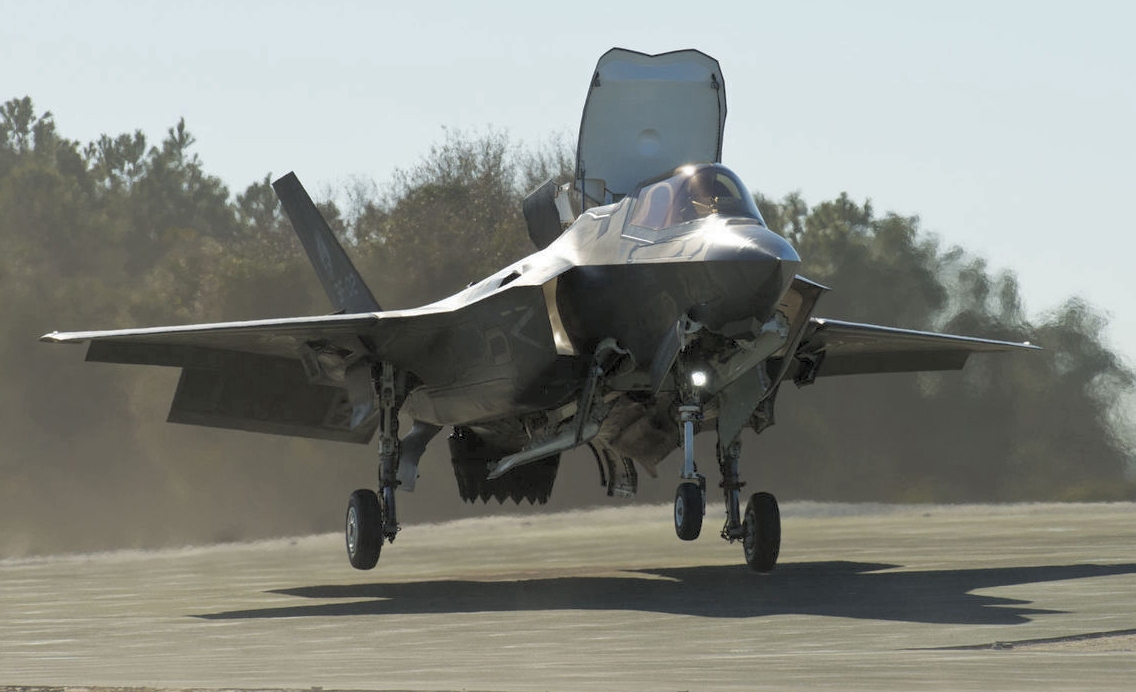PATUXENT RIVER, Md. (January 25, 2018)—The F-35 Patuxent River Integrated Test Force team brings the U.S. Marine Corps' F-35B one step closer to initial operational test and evaluation as they wrap up testing of the F-35B STOVL envelope with sloped surface vertical landing tests January and February at Marine Corps Auxiliary Landing Field (MCALF) Bogue, North Carolina.
"The Marine Corps is an expeditionary force capable of deploying on short notice to crises around the world-even to the most austere environments, and the F-35 has an exceptional expeditionary capability." said Maj. Michael Lippert, F-35 Pax River ITF test pilot and detachment officer-in-charge. "Conducting the testing at Bogue Field provides the Marine Corps with a unique opportunity to continue the test and development of the F-35 in the [short takeoff/vertical landing] mode, while simultaneously exercising components of the [Marine Air-Ground Task Force's] Air Combat Element, specifically the Marine Wing Support Squadrons at Bogue and MCAS Cherry Point."
The capability inherent in a STOVL jet allows the Marine Corps to operate in harsh conditions and from remote locations where few airfields are available for conventional aircraft-from abandoned or primitive runways, to long stretches of roadways. The aircraft can also operate from sites where Marines construct their own expeditionary runway or landing pads with AM-2 matting, similar to that used during the sloped surface testing.
Through a series of vertical landing maneuvers in simulated expeditionary conditions, the team's end goal will ease current sloped surface vertical landing requirements for the F-35B.
"We hope to be able to relax the landing pad certification limits in terms of maximum slope/gradients in the context of expeditionary pads-existing and future," said Bob Nantz, F-35 Pax River ITF Performance/Environmental Technical Specialist.
With Marines from the 2nd Marine Aircraft Wing capturing real-time lessons learned, some of the test results will be instantaneous. However much of the data will require significant analysis before any updates can be made to the fleet, Lippert said.
The Pax River ITF will analyze nearly 200 data test points to assess how well the F-35B operates on varying slopes, impacts of head and tailwinds, and the effect of aft center of gravity in conjunction with ground slopes.
"These updates will eventually make it to our fleet aircraft while the capabilities of the F-35 will continue to transform the way we fight and win," Lippert said.
Since the Marine Corps declared initial operational capability for the F-35B in July 2015, the service has been continuing to mature the platform, through tests like the sloped surface testing, to further refine the operational concepts that allow the service to fully leverage the air system's capability.
The F-35B is capable of conducting close air support, offensive and defensive counter air, air interdiction, assault support escort and armed reconnaissance as part of a Marine Air Ground Task Force, or in support of the Joint Force.
"Not only will this test expand the expeditionary envelope for the B variant, working with the Marine Wing Support Squadrons at Bogue and MCAS Cherry Point showcases their unique skillsets and demonstrates the ability for our Marines and their equipment to precisely build expeditionary sites suitable for F-35 operations," Lippert said.
Marines from the 2nd MAW staged the Bogue testing site for the Pax River ITF team by constructing sloped landing pads with AM-2 matting, the same matting Marines use to build airfields nearly anywhere around the world. Second MAW squadrons provide aviation ground support, enabling Marine Aircraft Groups to conduct expeditionary operations.
"Every opportunity that we get as a Marine Wing Support Squadron to provide aviation ground support is a highly valued opportunity," said Gunnery Sgt. Julio Silva, Marine Wing Support Squadron 274 Expeditionary Airfield Services chief. "The information gained will not only help the JSF but will also ensure that the expeditionary airfield capability is enhanced as we welcome the Marine Corps' newest generation of aircraft into fold."
F-35 Pax River ITF Expands Expeditionary Envelope for USMC with STOVL Tests

The Marine Corps' F-35 variant makes a vertical landing Jan. 16 at Marine Corps Auxiliary Landing Field Bogue, North Carolina, during sloped surface vertical landing testing. With the sloped surface tests, the F-35 Patuxent River Integrated Test Force team wraps up testing of the F-35B short takeoff/vertical landing envelope, bringing it one step closer to initial operational test and evaluation. Through a series of vertical landing maneuvers in simulated expeditionary conditions, the team's end goal is to expand warfighter capability for the F-35B, allowing vertical landings with relaxed sloped surface requirements. (Lockheed Martin photo by Dane Wiedmann)


